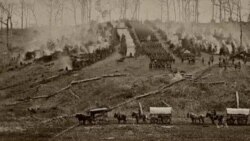One-hundred-fifty years ago Thursday, Confederate General Robert E. Lee surrendered his army to Union General Ulysses Grant, marking the end of the four-year U.S. Civil War that killed more than 700,000 people and freed the slaves.
Many consider it one of the most emotional moments in U.S. history. One reason the surrender scene was so dramatic is because the personalities of Lee and Grant reflected the two sides of the war.
Lee’s side, the South, included many large farms that depended on slave labor. The southern farm owners were often wealthy, polite and well-connected in society. Even though Lee was not wealthy, he belonged to a famous family.
“And he very much embodied the whole seigniorial, aristocratic, paternal element in the Old South, the slave-owning states," said David Ward, a senior historian at the Smithsonian Institution’s National Portrait Gallery.
In contrast, Grant’s family had neither money nor social influence. But he, like the North, was able to use the resources he had in a new way to achieve success. Grant eventually defeated Lee because Grant’s army had more food and supplies.
When it became clear that Lee could not continue to fight, the two generals agreed to meet at Appomattox Court House, in the eastern state of Virginia.
Lee arrived at the meeting well-dressed. Grant wore a dirty uniform. Their appearances, too, seemed to show their differences. But, as Ward explains, General Grant did not know the fighting was going to end and so did not have his best uniform ready.
The meeting was awkward, according to Ward, who said the men talked about unimportant things at first because they did not know what do to.
“Grant reminds Lee that they had met in the war with Mexico, and Lee, who is a much taller man, Lee looks down at Grant and says, ‘I don’t remember you at all.’ Which, I always think, it must be really tough to lose a war. And Lee at that point I think really feeling the fact that he’s having to surrender who he’s not regarding really as his equal,” said Ward.
Except for that moment, the two men behaved politely. Lee reminded Grant they were there to discuss the conditions of surrender. Grant sat down and quickly wrote them in a letter.
Most historians agree the conditions were generous. They permitted the southern soldiers to keep their horses and personal weapons. Grant also offered to feed the southern troops.
Ward points out the conditions dealt with only military issues. They did not force Lee to agree to political or social changes. In that way, he said, the conditions aimed to make it easier for the South and North to operate as one country again.
“It’s this moment where the society rips itself apart, remakes itself, and now everyone recognizes in some way, shape or form, through some compromise or another, we now have to put everything back together again," Ward said.
Indeed, when Lee left the building, Grant stopped the Northern troops from cheering. He said the two sides were no longer their enemies, and the best way to show the North’s joy was not to celebrate the South’s defeat.







